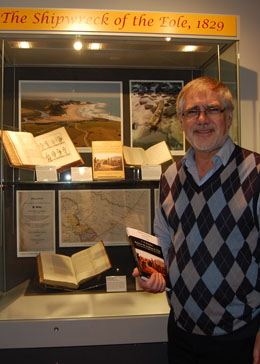Forgotten history rediscovered
 A long-lost chapter of South Africa’s history has been uncovered during an international quest by a researcher from the University of St Andrews.
A long-lost chapter of South Africa’s history has been uncovered during an international quest by a researcher from the University of St Andrews.
Dr David Culpin, a Reader in the University’s French Department, discovered an extremely rare book which contains an early record of interaction between Europeans and the indigenous Xhosa.
The book, Narrative of the Shipwreck of the French Vessel the Eole on the coast of Kaffraria in April 1829, tells the incredible tale of a shipwreck and how its survivors managed to trek almost 200 km across the bush to safety.
The book, which offers a rare account of encounters between Europeans and the indigenous population, gives a unique description of recently founded settlements that have now become important towns. Its eye-witness account offers a fresh insight into contemporary changes introduced in the administration of Cape Colony.
The text, which Dr Culpin found while studying books owned by Sir George Grey, a 19th century governor of the Colony of the Cape of Good Hope – modern South Africa – lay almost unnoticed for 183 years as it was written in French, at a time when most of the inhabitants of the Colony spoke English or Dutch. It is, in fact, the first French book and the first travel narrative published in South Africa.
Now, the tale of the Eole, a merchant vessel, that sank off the Wild Coast in the Eastern Cape is back in print, telling the story of the eight survivors who walked for three weeks barefoot to safety, at a time when an uneasy peace existed between the European settlers and the indigenous population.
Dr Culpin published an English translation in South Africa at the end of last year, and now in the UK, in French. There are just nine known original copies of the book in the world.
Dr Culpin said: “This book makes an important contribution to the history of Cape Colony in the nineteenth century, but it also speaks to issues of reconciliation and cross-cultural understanding that are relevant to modern South Africa.”
He is now returning to South Africa to conduct a tour of schools across the country to retell the story, originally written down on behalf of the survivors by Charles-Etienne Boniface, who himself had a fascinating life story as a refugee from the French revolution.
His research is the subject of an exhibition at MUSA (the Museum of the University of St Andrews) until March.
Notes to Editors
The Eole, a trading vessel, left Calcutta for Bordeaux, but was wrecked after leaving Réunion in April 1829, on a wild section of the African coast, beyond the eastern frontier of the Colony.
Just eight of the 20 passengers and crew survived and spent three days with the indigenous Xhosa people before their arduous trek across rough terrain to reach the nearest European settlement.
Against a backdrop of great unrest along the frontier between the Xhosa and the European settlers they finally reached Grahamstown, on the eastern frontier of the Colony, from where (the book tells us) Major William Boulden Dundas, a Scottish soldier, had led raids into Kaffraria.
The 120 subscribers to Boniface’s book (whose names are printed in the text) include not just Dundas, but also Anthony Oliphant, His Majesty’s Attorney General, a Scottish lawyer who had been appointed to the post in 1827.
For images please contact the press office.
Issued by the Press Office, University of St Andrews
Contact Fiona MacLeod on 01334 462108/ 0771 414 0559.
Ref: (bonniface 12/2/13)
View the University’s latest news at www.st-andrews.ac.uk/news
Category Research